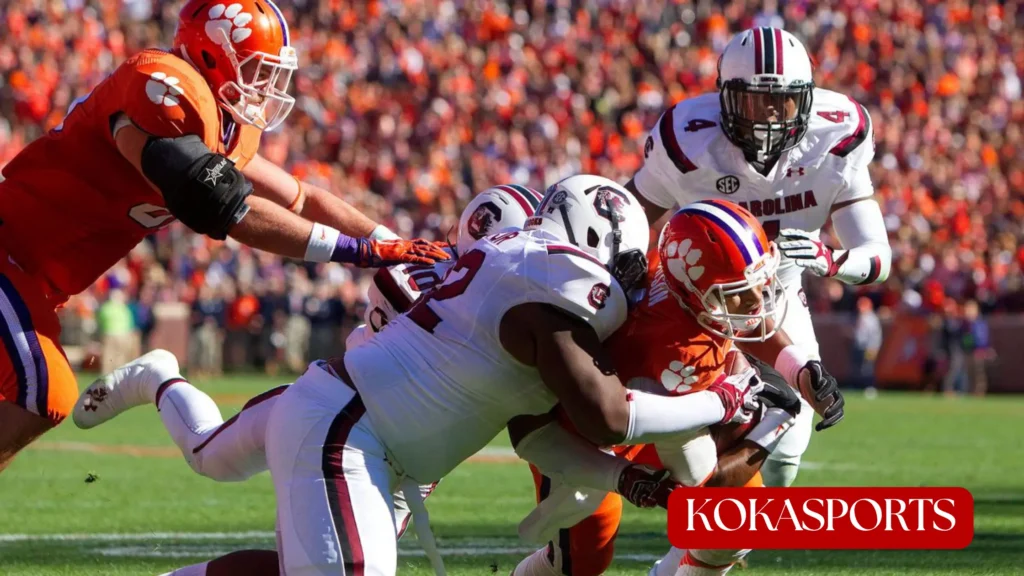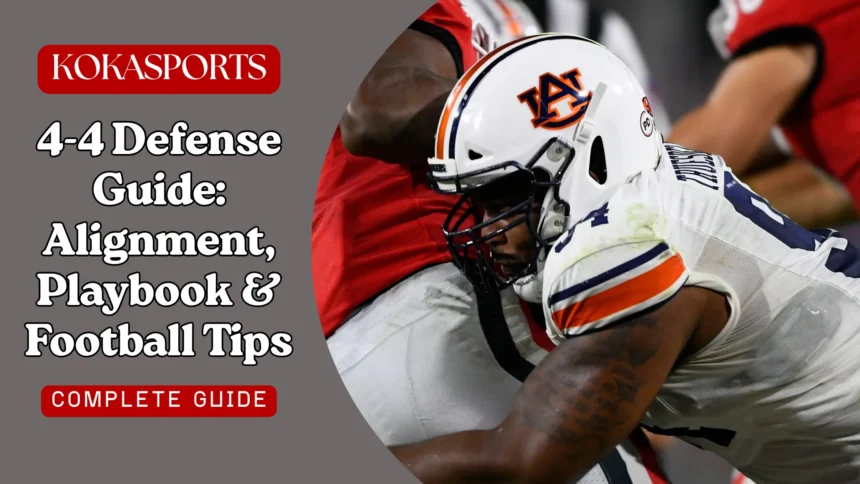The 4-4 defense stands as one of the most dependable and straightforward defensive schemes in american football. With four down linemen and four linebackers controlling the field, this formation creates an aggressive, run-stopping powerhouse that remains popular at every level of the game. Whether you’re coaching youth football or developing high school talent, the 4-4 offers simplicity, flexibility, and raw stopping power that few other systems can match.
What Is the 4-4 Defense? The Foundation of This Defensive System

The 4-4 formation places four defensive players on the line of scrimmage and four linebackers positioned behind them, with three defensive backs completing the unit. This creates an eight-man box designed to stop the run game before it starts. Unlike the 4-3 defense which uses three linebackers, or the 3-4 defense which features three down linemen, the 4-4 splits the difference perfectly.
Football coaches choose this defense when facing run-heavy opponents who rely on power schemes, counters, and physical ground attacks. The base alignment works especially well against traditional I-formation, Wing-T, and double-wing offenses that try to establish dominance at the point of attack. The structure also provides excellent edge containment, making it harder for running backs to bounce plays outside.
The personnel breakdown is straightforward: two defensive tackles control the interior gaps, two defensive ends manage the edges, two inside linebackers patrol the middle, and two outside linebackers handle force responsibilities on each side. The secondary consists of two cornerbacks and a safety, though teams often adjust to include a free safety and strong safety depending on offensive formations.
Read More: What Is a Touchback in Football? Complete Guide to the Touchback Rule
Historical Evolution of the 4-4
The 4-4 emerged as a hybrid between the older 5-3 and 6-2 defenses that dominated early football. As offenses became more sophisticated, coaches needed a formation that could maintain run strength while offering better pass coverage. High school programs quickly adopted the 4-4 because it required fewer specialized athletes than the 4-3 while still providing excellent gap control.
Modern variations like the 4-4 stack place linebackers directly behind defensive linemen, creating even more confusion for offensive blocking schemes. This alignment disguises blitz intentions and makes it harder for the offensive line to identify who’s rushing. The stack version gained popularity in youth football because it simplified teaching assignments while maintaining defensive integrity.
| Defense Type | Down Linemen | Linebackers | Best Against |
|---|---|---|---|
| 4-4 | 4 | 4 | Power running teams |
| 4-3 | 4 | 3 | Balanced offenses |
| 3-4 | 3 | 4 | Pass-heavy attacks |
| 6-2 | 6 | 2 | Old-school ground game |
Core Philosophy: Gap Control and Aggressive Play
The heart of the 4-4 defense revolves around disciplined gap control. Each defender owns specific gaps between offensive linemen, ensuring no running lane opens without a defender filling it immediately. The defensive tackle on each side typically plays a 3-technique position (outside shoulder of the guard) or sometimes a 1-technique (inside shade), while defensive ends line up in 5-technique or 7-technique positions depending on the offensive tackle and tight end presence.
Linebackers serve as the engine of this system. They read and react faster than any other position group, making them the true playmakers. Inside backers must diagnose quickly and attack downhill through the b gap or A-gap, while outside linebackers balance run support with edge-setting responsibilities. This versatility makes the 4-4 ideal for youth football coaches who want to develop athletic, aggressive players without overwhelming them with complex schemes.
The philosophy emphasizes aggression over passive reaction. Defenders attack upfield rather than reading and waiting, which disrupts offensive timing and forces offensive linemen to adjust on the fly. This approach works especially well against teams trying to establish the run game early, as the eight-man front collapses running lanes before they fully develop.
4-4 Alignment Explained: Positioning for Success

Base Front Structure
In the base 4-4, the defensive line creates the foundation. The dt (defensive tackle) on each side controls inside gaps, typically aligned 3 yards off the ball to read and react. The defensive end on the strong side (side with the tight end) plays outside the offensive tackle, while the weak side end mirrors this position. The middle of the field remains protected by inside linebackers who can flow to either side.
Outside linebacker positions (olbs) typically stand 4-5 yards off the ball, ready to force ball carriers inside or drop into coverage based on the play. These hybrid defenders must read quickly—a pulling guard might signal a sweep requiring outside force, while play-action demands immediate pass coverage drops.
The secondary aligns based on the coverage scheme. In cover 3, one safety patrols the deep middle while corners take deep thirds on each side. When facing spread formations, the defense might adjust to have both safeties deep, with the strong safety favoring the tight end side and the free safety playing center field.
Key Position Responsibilities
Inside linebackers represent the heart of the 4-4. They must recognize run plays instantly by reading the quarterback‘s mesh point and guard movements. When guards pull, these linebackers flow immediately to the point of attack. Against pass plays, they drop into hook and curl zones, providing underneath coverage that prevents quick completions.
The outside linebacker on each side faces the most complex assignment. Against the run, they must set the edge and force plays inside to waiting help. When teams try to cover the tight end in the pass game, the olb often carries this responsibility. This position requires speed, strength, and football intelligence—qualities that make it challenging to fill at youth levels.
Defensive lineman technique varies by coaching philosophy. Some football coaches prefer aggressive upfield penetration, while others emphasize gap integrity and controlled movements. The defensive tackle must handle double teams from guards and centers, while defensive ends battle offensive tackles who typically outweigh them. Proper technique—hand placement, leverage, and pad level—determines success far more than raw size.
Strengths of the 4-4: Why This Defense Works

Dominant Run Defense
The 4-4’s primary strength lies in its ability to stop the run immediately. With eight defenders near the line of scrimmage, running backs find no easy lanes. Power teams trying to establish physical dominance meet resistance at every gap. The formation forces offenses to be perfect—one missed block creates a tackle for loss rather than a modest gain.
Youth football teams particularly benefit from this structure. Young players grasp gap assignments more easily than complex zone responsibilities. When each defender owns a specific space, teaching becomes straightforward: “You have the c gap—nobody runs through your gap.” This clarity helps young players succeed quickly.
Versatility in Modern Football
Despite its traditional roots, the 4-4 adapts beautifully to modern offensive trends. Against spread offenses, the defense can easily shift to nickel packages by replacing a linebacker with an extra defensive back. The alignment maintains gap integrity while improving pass coverage against four- and five-receiver sets.
Blitz packages flow naturally from the 4-4 structure. With four linebackers, the defensive coordinator can send pressure from multiple angles without major adjustments. An inside backer through the A-gap, an olb off the edge, or even a delayed safety blitz from depth—all work seamlessly because the base structure supports aggressive play.
Weaknesses and Challenges: What Can Go Wrong

Vulnerability Against Passing Attacks
The 4-4 defense shows its age against modern passing offenses. With only three defensive backs, teams face stress when offenses spread the field. Slot receivers create natural mismatches against linebackers in coverage, and quick passing games attack before the pass rush arrives. The passing game exploits the 4-4 by forcing linebackers into space where their size becomes a liability.
Spread offenses with four receivers force difficult decisions. Do you bring in an extra defensive back, essentially shifting to a 4-3 nickel look? Or do you keep the 4-4 and accept that a linebacker will cover a slot receiver? Both options carry risks, and smart offensive coordinators attack these vulnerabilities ruthlessly.
Personnel Requirements
The 4-4 demands quality linebacker play more than any other position group. If inside linebackers misread plays, massive running lanes open instantly. If outside linebackers fail to set edges, sweeps and tosses turn into big plays. Youth football coaches often struggle to find four quality linebackers, forcing them to play less athletic defenders in positions that require speed and instincts.
Defensive ends need a unique skill set too. They must be strong enough to hold the edge against double teams yet fast enough to contain mobile quarterbacks on scrambles. Finding this balance proves difficult, especially when the offensive tackle across from them outweighs them by 50 pounds.
Blitz Packages: Bringing the Pressure
The 4-4 creates natural blitz lanes that require minimal disguise. An inside backer can shoot the b gap off the blocker‘s inside shoulder while the defensive lineman occupies his block. Outside pressure comes from olbs who can time their movement with the snap, arriving at the qb as he reaches his drop depth.
Blitz packages work best when combined with sound coverage behind them. Sending six rushers means only five defenders remain in coverage, so the scheme must account for hot routes and quick throws. Man coverage pairs well with aggressive blitzing because it assigns specific defenders to receivers, though it requires cornerbacks capable of winning one-on-one matchups.
Defensive end stunts and tackle loops add another wrinkle. When the dt loops outside while the defensive end crashes inside, offensive linemen must communicate perfectly or one rusher comes free. These games create confusion and disruption even when they don’t produce sacks.
Coverage Schemes: Protecting the Deep Field
Cover 3 serves as the most common coverage in the 4-4. With three deep defenders splitting the field into thirds, the zone defense provides solid protection against deep balls while keeping defenders in position to support the run. Linebackers drop into underneath zones, taking away crossing routes and providing lanes for the pass rush.
Zone coverage schemes match the 4-4’s aggressive mentality. Rather than trailing receivers, defenders protect specific areas and break on throws. This approach requires less elite athleticism than man coverage but demands excellent recognition skills. Youth football players learn zone concepts more easily, making it an ideal starting point.
When facing exceptional receivers, teams might shift to press-man techniques at the line of scrimmage. This approach disrupts timing routes and gives the pass rush extra time to reach the quarterback. However, it requires cornerbacks with the confidence and skill to win individual battles.
Installing the 4-4: Teaching Your Team
Youth football coaches appreciate how quickly players grasp 4-4 concepts. Start with gap assignments, using simple language: “You own the space between the guard and tackle—that’s your home.” Progress to reading keys—guards for inside linebackers, tight ends for olbs—until players react instinctively.
Practice drills should build from individual techniques to full team execution. Defensive linemen work on defeating blocks, linebackers practice reading and filling, and defensive backs refine their coverage skills separately before combining them. Group drills that sync the front seven together help players see how their assignments fit the larger scheme.
A basic playbook needs clear diagrams showing alignment, gap responsibilities, and coverage rules. Include simple terminology that players remember under pressure. Rather than complex names, use numbers or colors that young athletes process quickly. The best football defensive systems balance sophistication with teachable simplicity.
When to Use the 4-4 and When to Adjust
The 4-4 defense excels against traditional power running teams that line up in tight formations. Wing-T, double-wing, and I-formation offenses meet their match against the eight-man front. Teams relying on pulling guards, trap plays, and power schemes find no easy answers when every gap contains a defender.
However, when facing spread offenses with four or five receivers, the 4-4 must adjust or risk getting picked apart. Smart defensive coordinators shift to nickel packages, essentially creating a 4-3 look with extra defensive backs. This flexibility keeps the system viable against diverse offensive styles.
Against mobile quarterbacks running read-option schemes, assignment discipline becomes critical. The outside shoulder of the offensive tackle serves as the key landmark for defensive ends, who must maintain coverage responsibility on the qb while not abandoning the run game. One defender missing his assignment creates explosive plays.
Conclusion:
The 4-4 defense continues to thrive because it delivers what football coaches need most: reliable run defense, simple teaching progressions, and natural flexibility. While the scheme has evolved since its early days, the core principles remain sound. Eight defenders attacking downhill, disciplined gap control, and aggressive linebacker play create a foundation that works at every level.
For youth football programs, the 4-4 represents perhaps the best football starting point. Young players learn faster, gain confidence quicker, and develop proper defensive instincts within this structure. As they advance, coaches can layer in complexities like varied blitz looks, multiple coverage schemes, and formation adjustments without abandoning the core system.
The 4-4’s legacy lives on in modern hybrid defenses that borrow its principles. Even NFL teams running multiple fronts incorporate 4-4 concepts when facing power running attacks. Its simplicity never goes out of style, and its effectiveness against the run game ensures the 4-4 will remain a staple of football defensive strategy for generations to come.
FAQs
What is the 4-4 defense good for?
Great for stopping the run and bringing pressure.
What is the weakness of the 4-4 defense?
Weak against spread and strong passing attacks.
Why was it called the 46 defense?
Named after Bears safety Doug Plank, who wore #46.
How to beat a 4-4 defense?
Use spread sets, quick passes, and misdirection.



